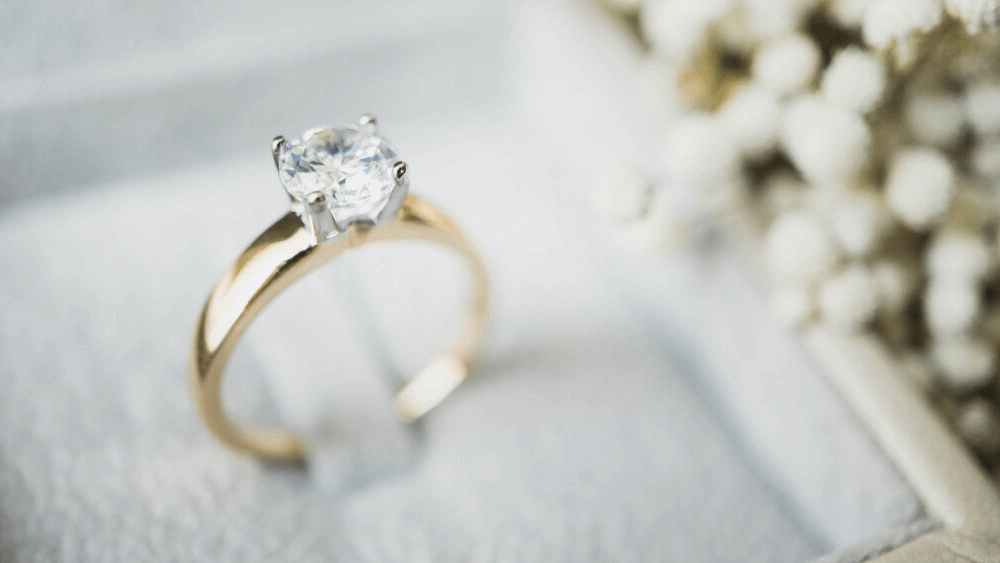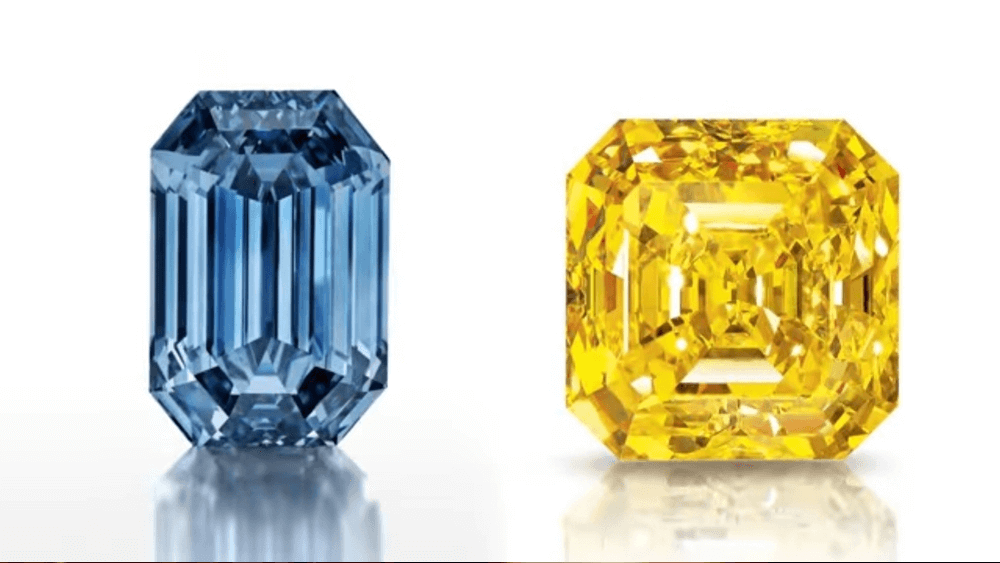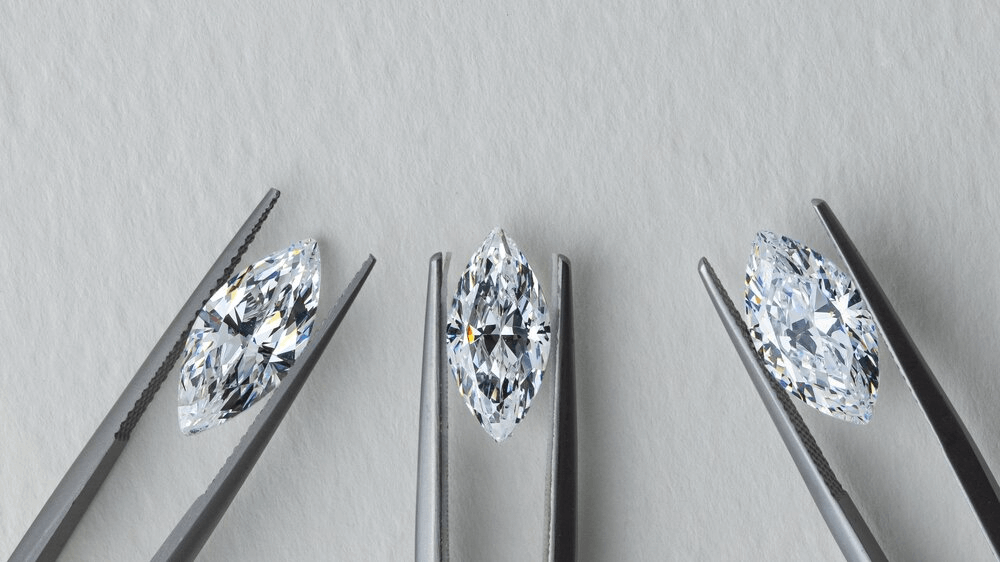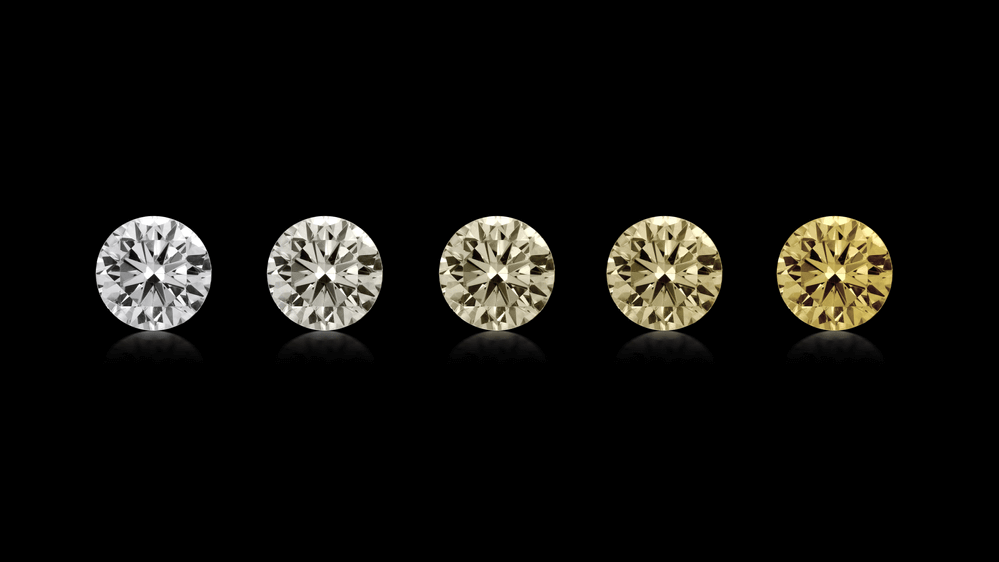The Shocking Truth About Diamond Carat Size

By Gary A.

Edited by Olivia H.
Published Nov 12, 2022
Edited on Mar 31, 2025
Choosing the right carat size for your diamond ring involves more than just picking a number—it’s about finding the perfect balance between size, quality, and overall visual impact.

Navigate This Guide:
- 7 Quick Tips for Selecting the Perfect Carat Size in Diamond Engagement Rings
- Introduction to Carat Size
- The Basics of Diamond Carats
- Decoding the Carat System
- How to Choose the Right Carat Size
- Carat Diamond Charts
- Our Expert Take
- 10 Frequently Asked Questions About Diamond Carat Sizes
Before we dive deeper into the specifics, here are some practical tips to help guide your decision-making process:
7 Quick Tips for Selecting the Perfect Carat Size in Diamond Engagement Rings
- Tip 1: Understand the Carat vs. Size Perception Tip: Recognize that carat weight doesn’t always equate to the diamond’s visible size. A diamond’s cut and shape influence how large it appears. Use a diamond size chart to visualize how different carat weights look in various cuts and shapes.
- Tip 2: Consider the Ring’s Band Width and Style Tip: The band’s width can impact how the diamond appears. A slender band can make a smaller carat diamond look larger, while a wider band may require a bigger diamond to maintain proportion. Align your choice with the ring’s overall design.
- Tip 3: Balance Carat Size with Overall Quality Tip: Don’t focus solely on carat size. A larger diamond with poor clarity, color, and cut may be less appealing than a smaller, higher-quality diamond. Prioritize a balance between carat size and the other 3Cs (Cut, Color, Clarity) for the best aesthetic appeal.
- Tip 4: Pay Attention to Diamond Shapes and Proportions Tip: Different shapes can influence the perceived size of the diamond. For instance, elongated shapes like oval or marquise can appear larger than round diamonds of the same carat weight. Examine the diamond’s proportions using a size chart to ensure a flattering appearance.
- Tip 5: Evaluate the Setting’s Impact on Diamond Size Tip: The setting can either highlight or overshadow the diamond’s size. A halo setting, where smaller diamonds encircle the main stone, can make the center diamond appear larger. Contrastingly, a bulky setting might make the diamond seem smaller.
- Tip 6: Consider the Finger Size and Hand Proportions Tip: The diamond’s appearance can vary significantly depending on the wearer’s finger size. Larger carat diamonds may overwhelm small fingers, while they might look proportionate on larger fingers. Use a size chart to find a carat size that complements the wearer’s hand.
- Tip 7: Be Aware of the Diamond’s Table Size Tip: The table size, or the top flat surface of the diamond, can affect how large the diamond looks. A larger table can make the diamond appear bigger, but it should be proportionate to the rest of the stone for optimal light reflection and brilliance.
Now that you’ve got these practical tips, use Jeweler AI below to find the perfect engagement ring that suits your style and budget:
Introduction to Carat Size
When it comes to diamonds, bigger doesn’t always necessarily mean better. Even engagement rings – the ultimate landing place for any diamond – can stand out as true winners without needing to rely on a 10 carat stone to make them impressive.
But we’re getting ahead of ourselves. First of all, it pays to understand exactly what we mean by the term ‘carat’ and how diamond carat size affects the appearance and value before you start worrying over your own diamond’s carat
Carat is a specific weight measurement used on gemstones and pearls. It is equal to 0.2 grams, or 200 milligrams.
This unit of measurement is used around the world, meaning that, while it doesn’t tell us anything concrete about a diamond’s surface diameter, it’s pretty easy to gauge a rough idea based on carat alone (more on that below).
Carats are also assigned points, so you may see a diamond referred to as a ‘one pointer’. This simply means one carat.
The Basics of Diamond Carats
While the most common tiers are 0.5, 1, 1.5, 2, and, after that, whole carat increments, a diamond’s carat weight can be any number, though it is carried out to two decimal places.
As you might have noticed by now, diamonds that weigh less than one carat can be presented as fractions or decimals of 1 carat. A 0.5 carat diamond, for instance, weighs exactly 100 milligrams, while a 0.1 carat diamond will weigh 20 milligrams, or 0.02 grams – or, alternatively, 1/10th of a carat.
It’s important to remember that carat weight is not the same as size. The carat and mm size of a diamond depends on its shape and proportions, although it’s worth having a rough expectation of what size a 1, 2, 3 or 5 carat diamond will be. This will help a lot with diamond carat size comparison.
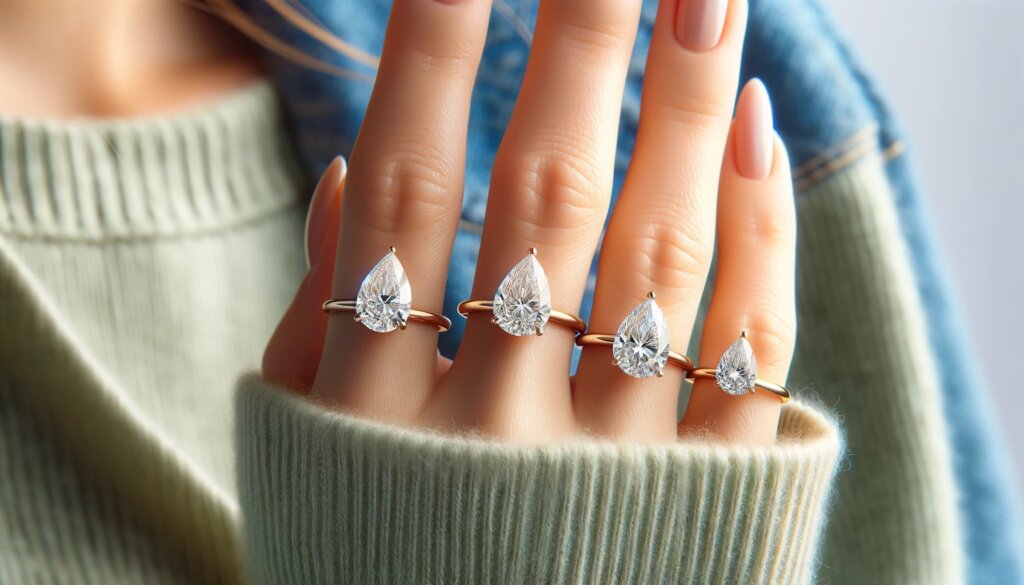
Here are charts showing the approximate dimensions for various diamond shapes, from 1-carat to 5-carat weight. These charts provide a visual aid for understanding the typical sizes of different shaped diamonds:
1ct Average Size Carat Diamond Chart
| Diamond Shape | Approximate Dimensions (mm) |
|---|---|
| Round | 6.5 (diameter) |
| Oval | 7.5 x 5.5 |
| Princess | 5.5 x 5.5 |
| Cushion | 6.0 x 6.0 |
| Radiant | 5.5 x 5.5 |
| Marquise | 10.0 x 5.0 |
| Emerald | 7.0 x 5.0 |
| Pear | 8.5 x 5.5 |
2ct Average Size Carat Diamond Chart
| Diamond Shape | Approximate Dimensions (mm) |
|---|---|
| Round | 8.2 (diameter) |
| Oval | 9.0 x 7.0 |
| Princess | 7.5 x 7.5 |
| Cushion | 7.5 x 7.5 |
| Radiant | 7.5 x 7.5 |
| Marquise | 13.0 x 6.5 |
| Emerald | 8.5 x 6.0 |
| Pear | 10.5 x 7.0 |
3 Carat Average Size Carat Diamond Chart
| Diamond Shape | Approximate Dimensions (mm) |
|---|---|
| Round | 9.4 (diameter) |
| Oval | 10.5 x 8.0 |
| Princess | 8.5 x 8.5 |
| Cushion | 8.5 x 8.5 |
| Radiant | 9.0 x 8.0 |
| Marquise | 15.0 x 7.5 |
| Emerald | 9.5 x 7.0 |
| Pear | 11.0 x 7.5 |
5ct Average Size Carat Diamond Chart
| Diamond Shape | Approximate Dimensions (mm) |
|---|---|
| Round | 11.0 (diameter) |
| Oval | 12.0 x 9.0 |
| Princess | 9.5 x 9.5 |
| Cushion | 9.5 x 9.5 |
| Radiant | 9.5 x 9.5 |
| Marquise | 18.0 x 9.0 |
| Emerald | 11.0 x 8.0 |
| Pear | 15.0 x 10.0 |
Diamond size vs carat weight is a big topic but, ultimately, comes down to preference. Remember that jewelers talk in terms of carat weight, so consider focusing on this rather than any size measurement.
Since carat is shown to two decimal places, weight may be rounded up – although not in the case of magic sizes, which we will look at just below.
For now, however, we’ll leave you with this. A diamond that weighs 234.9 milligrams will be presented as 2.35 carats, while a diamond that weighs 199.7 will be presented as 1.99 carats, rather than 2. You might already be able to work out why that is but, if not, here’s a brief explainer on ‘magic diamond sizes’.

Decoding the Carat System
Sort your carats from your carrots, and make diamond shopping a breeze…
Carat vs Karat: Clearing the Confusion
A diamond’s carat is its weight, while the proportion of gold to its alloys is measured in karats.
This is something that can easily trip up first-time buyers of fine jewelry as, unless you’re looking exclusively at platinum for your ring, both diamond carat and gold karat are bound to crop up pretty frequently.
The most important thing to understand is that, while the two terms sound similar, they refer to totally different things.
Rather than weight or size, karat represents 1/24th of a piece of gold, meaning that 24 karat gold is totally pure. Unfortunately, pure gold is way too soft and damage-prone to be used in jewelry, so it’s alloyed with other, strengthening metals – which, in turn, drive down the purity of that piece of gold. 18 karat gold, then, is 18 ‘parts’ gold to 6 ‘parts’ alloying metals, like silver, palladium, or platinum.
Interestingly, this is why rose gold (which takes its pink-ish color from copper and silver) could never be 24k, and why it’s so much stronger than 24k gold.
So the term ‘karat’ (confusingly spelled carat outside of the US) refers to proportion, while carat is exclusively used as a unit of measurement for gemstones.
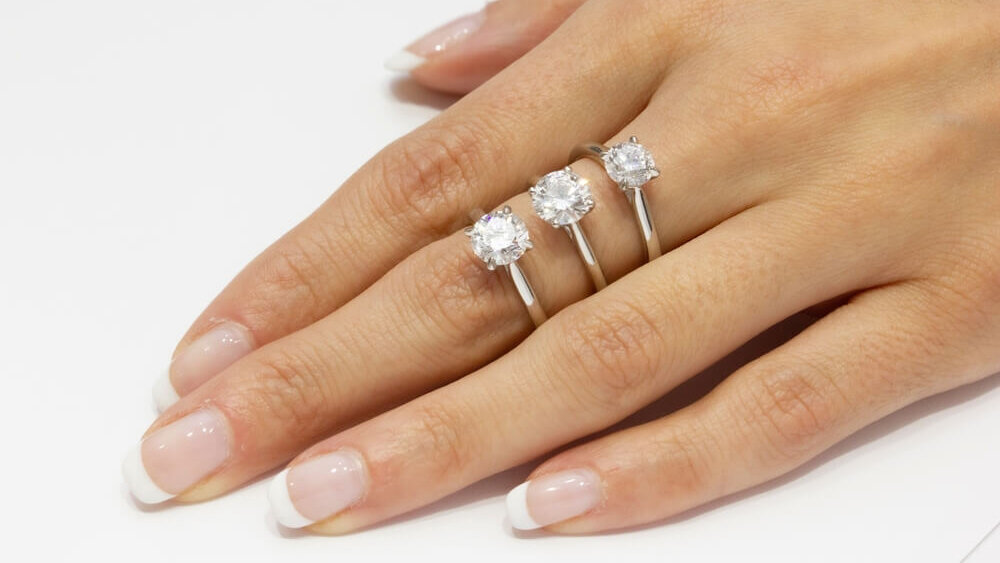
How Big is a Carat? Why Size Matters in Diamonds
Size and carat weight is a very important distinction for shoppers to make. Since carat refers to weight only, two diamonds of the same shape and carat weight could feature totally different weight distributions, making them appear totally different sizes.
A 2 carat diamond that looks significantly larger than every other 2 carat diamond is not a ‘great find’ – it’s an example of how poorly a cut can be completed, and how much an otherwise beautiful diamond can suffer from it.
While it may feel restrictive, sticking to the ideal cut proportions means ensuring that your diamond is not only big but beautiful too. It will create plenty of fire, brilliance, and scintillation, and it won’t appear squat or, conversely, stretched out and ‘skinny’.
Carat does not determine weight distribution, which means that it only tells half the story. As a shopper, you’ll want to get used to the right proportions for your chosen shape.
How to Choose the Right Carat Size
We wouldn’t blame you if you’re feeling ‘big diamond envy’ right now, but it’s vital you take a step back and think carefully about balancing size against quality.
Balancing Size with Quality
Big diamonds are great. They’re impressive, high-status possessions that attract a lot of positive attention from pretty much anyone who happens to be in the same room. It’s understandable why we set so much store by size, but it’s important not to fall into the trap that has claimed so many shoppers in the past – believing that the only thing that matters is carat weight and that everything else is just a secondary concern.
A low-quality, large diamond may be impressive from afar but, up close, it’s going to be a huge disappointment. From a stained, yellow appearance to visible inclusions – or even the dreaded bow tie – will undermine all that natural beauty and leave you with something that looks like it could have come from the mall.
Big diamonds are still priced high, even if they’re badly included because some jewelers still capitalize on shoppers who don’t know better. Don’t waste your money – shop from a jeweler who cares a lot more about selecting truly beautiful diamonds that are worth your money. But a big diamond carat size on the hand will fail to impress if it’s murky, cloudy, asymmetrical and visibly included.
This is at the core of what we do at WillYou – reviewing every diamond we add to our curation against our own set of high standards for shape, size, beauty, and value.
Off Size Diamonds: The Unconventional Choice
Off size diamonds are an alternative to magic sizes – think 0.5, -.75 or 1 carat, which are considered to be more sought-after than diamonds that sit between these sizes. An off size diamond is a more cost-effective option.
If you’re hoping to use a 1 carat diamond in your engagement ring, then the odds are that you’re less likely to settle instead on a 0.99 carat diamond. It’s not unheard of, and can be a good way of saving a little money but, in general, the emphasis is placed on quarter- and half-sizes (whether that’s 0.25 carats, 1 carat, 1.5 carats), rather than the many sizes that exist in-between.
This is why the 199.7 carat diamond would not be rounded up to 2 carats, while the 234.9 carat diamond could be presented as a 235 carat stone.
There is, of course, no noticeable difference between a 0.49 carat diamond and a 0.5 carat diamond, or a 0.99 carat diamond and a 1 carat diamond, but, for obvious reasons, they are the more popular sizes among buyers.
Practical Considerations When Choosing Carat Size
- The wearers’ lifestyle matters a lot – big diamonds aren’t exactly heavy (a 5 carat diamond, for instance, still weighs just 1g), but they’re still impractical if the wearer has a busy life and wants to wear their engagement ring on more than just special occasions.
- Size isn’t everything – we can’t stress that point enough!
- A bigger diamond often means you need to be more cautious about the sort of ring setting you’re going for. If you want to keep the ring looking minimalistic with as little ‘interruption’ from prongs as possible, go for a smaller diamond. Bigger diamonds inevitably need heavier-duty settings.
The Setting’s Impact on Diamond Size Perception
A diamond carat size guide is useful for finding a weight you’re happy with, but it’s vital you keep your mind on the end result. Some settings are designed to make diamonds appear as big as possible by exposing a large amount of surface area to the light, making them sparkle more and shine brighter. Prongs are great for this, and some rings will feature as little as three prongs to prevent the edges of the diamond from being hidden – and, as a result, making it appear smaller.
Of course, lightweight and unobtrusive ring designs aren’t as secure, so there’s a big pay-off to think about.
Some settings, like the bezel, are a lot more obtrusive. They block light and cover the diamond’s outer edge (girdle). This doesn’t necessarily mean you should avoid them altogether – the results can be beautiful – but, if you’re going for a bezel, consider getting a larger stone to compensate for the lost real estate on the finger.
Carat Diamond Charts
Round Diamond Size Chart
| Carat Weight | Approximate Diameter (mm) |
| 0.5 | 5.2 |
| 0.75 | 5.9 |
| 1.00 | 6.5 |
| 1.25 | 7 |
| 1.50 | 7.4 |
| 1.75 | 7.8 |
| 2.00 | 8.2 |
| 2.50 | 9 |
| 3.00 | 9.4 |
| 4.00 | 10.4 |
| 5.00 | 11 |
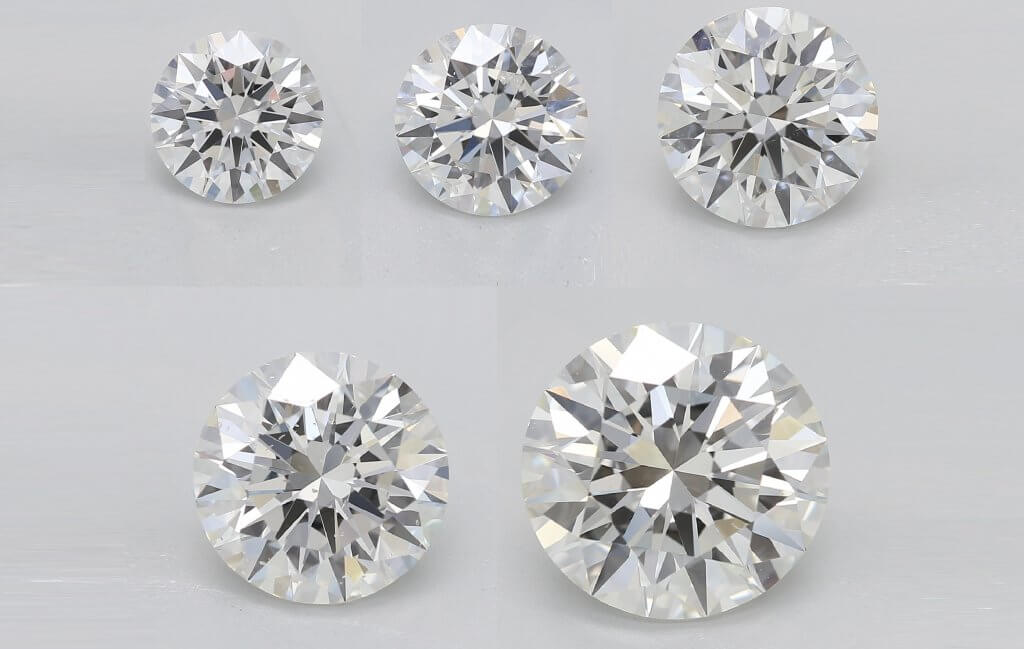
Oval Diamond Carat Size Chart
| Carat Weight | Approximate Diameter (mm) |
| 0.5 | 6.0×4.0 |
| 0.75 | 7.0×5.0 |
| 1.00 | 7.5×5.5 |
| 1.25 | 8.0×6.0 |
| 1.50 | 8.5×6.5 |
| 1.75 | 9.0 x 6.5 |
| 2.00 | 9.0×7.0 |
| 2.50 | 10.0×7.5 |
| 3.00 | 10.5×8.0 |
| 4.00 | 11.5×8.5 |
| 5.00 | 12.0×9.0 |
Princess Cut Diamond Carat Size Chart
| Carat Weight | Approximate Diameter (mm) |
| 0.5 | 4.5×4.5 |
| 0.75 | 5.0×5.0 |
| 1.00 | 5.5×5.5 |
| 1.25 | 6.0×6.0 |
| 1.50 | 6.5×6.5 |
| 1.75 | 7.0×7.0 |
| 2.00 | 7.5×7.5 |
| 2.50 | 8.0×8.0 |
| 3.00 | 8.5×8.5 |
| 4.00 | 9.0×9.0 |
| 5.00 | 9.5×9.5 |
Emerald Diamond Carat Size Chart
| Carat Weight | Approximate Length x Width (mm) |
|---|---|
| 0.50 | 5.0 x 3.5 |
| 0.75 | 6.0 x 4.0 |
| 1.00 | 6.5 x 4.5 |
| 1.25 | 7.0 x 5.0 |
| 1.50 | 7.5 x 5.5 |
| 1.75 | 8.0 x 5.5 |
| 2.00 | 8.5 x 6.0 |
| 2.50 | 9.0 x 6.5 |
| 3.00 | 9.5 x 7.0 |
| 4.00 | 10.5 x 7.5 |
| 5.00 | 11.5 x 8.0 |
Cushion Diamond Carat Size Chart
| Carat Weight | Approximate Length x Width (mm) |
|---|---|
| 0.50 | 4.5 x 4.5 |
| 0.75 | 5.0 x 5.0 |
| 1.00 | 5.5 x 5.5 |
| 1.25 | 6.0 x 6.0 |
| 1.50 | 6.5 x 6.5 |
| 1.75 | 7.0 x 7.0 |
| 2.00 | 7.5 x 7.5 |
| 2.50 | 8.0 x 8.0 |
| 3.00 | 8.5 x 8.5 |
| 4.00 | 9.0 x 9.0 |
| 5.00 | 9.5 x 9.5 |
Radiant Diamond Carat Size Chart
| Carat Weight | Approximate Length x Width (mm) |
|---|---|
| 0.50 | 5.0 x 4.0 |
| 0.75 | 5.5 x 4.5 |
| 1.00 | 6.0 x 5.0 |
| 1.25 | 6.5 x 5.5 |
| 1.50 | 7.0 x 6.0 |
| 1.75 | 7.5 x 6.5 |
| 2.00 | 8.0 x 7.0 |
| 2.50 | 8.5 x 7.5 |
| 3.00 | 9.0 x 8.0 |
| 4.00 | 10.0 x 8.5 |
| 5.00 | 10.5 x 9.0 |
Marquise Diamond Carat Size Chart
| Carat Weight | Approximate Length x Width (mm) |
|---|---|
| 0.50 | 7.5 x 3.5 |
| 0.75 | 9.0 x 4.5 |
| 1.00 | 10.0 x 5.0 |
| 1.25 | 11.0 x 5.5 |
| 1.50 | 12.0 x 6.0 |
| 1.75 | 12.5 x 6.5 |
| 2.00 | 13.0 x 6.5 |
| 2.50 | 14.0 x 7.0 |
| 3.00 | 15.0 x 7.5 |
| 4.00 | 16.5 x 8.5 |
| 5.00 | 18.0 x 9.0 |
Pear Diamond Carat Size Chart
| Carat Weight | Approximate Length x Width (mm) |
|---|---|
| 0.50 | 6.0 x 4.0 |
| 0.75 | 7.0 x 4.5 |
| 1.00 | 8.0 x 5.0 |
| 1.25 | 8.5 x 5.5 |
| 1.50 | 9.0 x 6.0 |
| 1.75 | 9.5 x 6.5 |
| 2.00 | 10.0 x 6.5 |
| 2.50 | 10.5 x 7.0 |
| 3.00 | 11.0 x 7.5 |
| 4.00 | 12.0 x 8.0 |
| 5.00 | 13.0 x 8.5 |
Our Expert Take
There is no ‘ideal’ carat weight for any piece of jewelry – particularly engagement rings. The best thing you can do is learn about this unit of measurement, and how to make it work for you.
It’s not always easy wrapping your head around the specifics of diamond carats. For one thing, it’s pretty difficult to gauge a rough price point for any specific carat weight, given the massive discrepancies that can exist between one diamond and the next – even if they are exactly the same carat weight.
For another, the different ways individual jewelers and experts present a diamond’s carat weight can mean you have to do some mental gymnastics to get it all straight in your head. In other words, when a seventy-three pointer means the same thing as a 0.73 carat diamond – which might also be presented as 0.73 ct or ¾ of a carat – it’s not always easy to keep your head straight.
Still, it won’t take long before you start to feel more comfortable with this particular unit of measurement – and, in particular, with using it as a way of sorting through the massive numbers of diamonds on the market today to find one that is perfect for your vision for that ring.
10 Frequently Asked Questions About Diamond Carat Sizes
- What is a Carat in Diamonds?
A carat is a unit of weight used to measure the size of a diamond. One carat is equivalent to 200 milligrams. - How Big is a One Carat Diamond?
A one carat diamond, depending on its shape and cut quality, typically measures around 6.5mm in diameter. - Does a Higher Carat Mean a Bigger Diamond?
Yes, a higher carat indicates a heavier, and often bigger, diamond. However, cut and shape can affect how large the diamond actually appears. - What is the Difference Between Carat and Karat?
Carat refers to the weight of a diamond, while karat is a measure of the purity of gold. - Is a 1 Carat Diamond Considered Large?
A 1 carat diamond is considered significant and is a popular choice for engagement rings, though it’s not the largest size available. - How Can I Tell the Carat Size of a Diamond?
The carat size is typically provided by the jeweler. For an existing diamond, a professional jeweler can measure the weight using specialized tools. - Does Carat Size Affect the Price of a Diamond?
Yes, larger carat sizes generally increase the price of a diamond, but other factors like cut, color, and clarity also play a crucial role in determining the price. - What Does ‘Off Size’ Diamond Mean?
‘Off size’ diamonds are those that don’t fit into the standard carat sizes and are often slightly smaller. They can offer better value for money. - Can Two Diamonds of the Same Carat Weight Look Different in Size?
Yes, the cut and shape of a diamond can make two diamonds of the same carat weight appear different in size. - What is a Good Carat Size for an Engagement Ring?
This depends on personal preference and budget. A 1 carat diamond is a popular choice, but some may opt for slightly larger or smaller based on style and financial considerations.
Struggling with maximizing your diamond carat size? Let Jeweler AI find your ideal match! Get Started
FOLLOW-UP GUIDE SERIES

